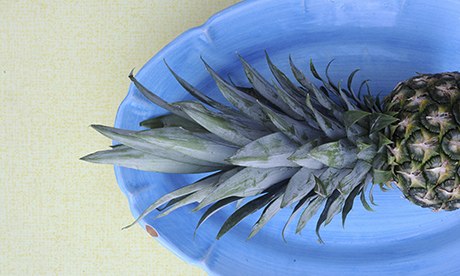
In summer, when berries are abundant, what's the point of pineapple? Why bother wrestling with that spiky intruder when there are home-grown seasonal fruits to eat? But at this time of year, as a complement to autumn's still firm British apple and pear crop, and leafy Spanish and Moroccan citrus, sweet-sharp, heady pineapple really finds a purpose.
We now know that the pay and conditions of workers in tropical places who labour in pineapple fields are often notoriously bad – a powerful argument for buying only Fairtrade pineapples. With this guarantee, you know that the people who grew your fruit earned a living wage and received a little extra premium to use for community projects.
Let your nose be your guide to selecting a pineapple that will eat well. It should smell fragrant, but not of boiled sweets (too ripe) or dank drains (too long in storage).
Why is pineapple good for me?
Pineapple contains a compound called bromelain. The protein-digesting enzymes in it are thought to aid digestion. While not all studies agree on its effectiveness, bromelain is used worldwide as an anti-inflammatory, an anti-coagulant, and is thought to have anti-cancer properties.
Pineapple is an outstanding source of vitamin C, and the mineral manganese, both of which help protect against cell damage caused by free radicals. Manganese is also essential in producing several enzymes needed for energy production.
Since pineapple is a very sweet fruit, it's best to eat it in its natural form, rather than as a juice, because the soluble fibre it contains slows down the rate at which sugar is released as you digest it. Consumption of sweet juices causes spikes in blood sugar and insulin levels, which can encourage the body to produce and store fat.
Where to buy and what to pay
Supermarket guide price: £1.70- £1.89
Joanna Blythman is the author of What To Eat (Fourth Estate, £9.99). To order a copy for £7.99 with free UK p&p, go to theguardian.com/bookshop
Pineapple relish
This is a cross between a salsa and a relish and means you can have the lovely fresh flavours of pineapple any time of the year. Make this now and you'll have the perfect accompaniment to your leftover Christmas ham. It will make about two 450g jars.
2 red onions, peeled and finely sliced
1 tsp salt
350ml cider vinegar
2 tsp yellow mustard seeds
1 tsp ground allspice
2 small hot red chillis, deseeded, kept whole
5cm piece ginger, peeled and grated
150ml light brown soft sugar
1 large pineapple – about 1kg peeled and trimmed – cut into 3cm chunks
75g dried cranberries
Juice of 2 limes, and the zest of one
1 Put the onion, salt and vinegar in a pan, add the spices, chilli and ginger and simmer until the onions are beginning to soften – this will probably take 7-10 minutes.
2 Now add the sugar and stir to dissolve. Once the sugar has completely dissolved, add the pineapple, dried cranberries and finally the lime juice and zest. Bring to the boil and simmer for about 15 minutes until the pineapple is translucent and soft.
3 Cool a little, then spoon into clean warm jars while still hot and seal. Keep the relish in the fridge once opened.
Rosie Sykes is head chef of Fitzbillies (fitzbillies.com) and co-author of The Kitchen Revolution (Ebury Press, £25). To order a copy for £19.99 with free UK p&p, go to theguardian.com/bookshop

